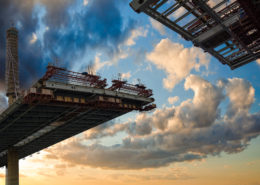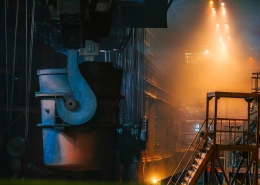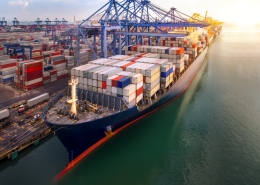On Wednesday, the U.S. House Transportation and Infrastructure subcommittee on Railroads, Pipelines, and Hazardous Materials met for a hearing on Amtrak and intercity passenger rail oversight. Witnesses provided insight on issues related to service and performance improvements, federal support, and accountability of intercity passenger rail in the United States.
Witness List
Context
In recent years, passenger rail has seen a growth in attention, investment, improvements, and expansions across the United States. The COVID-19 Pandemic brought passenger rail to a grinding halt. Amtrak, the nation’s primary passenger rail provider, has seen ridership get back on track following the pandemic throughout its system. Other passenger rail providers like Brightline have introduced higher speed trains to Florida, and proposed services between Las Vegas and Southern California.
The Infrastructure Investment and Jobs Act (IIJA) has provided historic federal funding for passenger rail that has spurred investment, interest, and efforts to expand and improve passenger rail across the country. Passenger rail funding within the IIJA totals around $66 billion, which is to be utilized through various grant programs aimed at improving service, expanding services, and improving rail and safety infrastructure, among other goals.
In December 2023, the Federal Railroad Administration (FRA) awarded $8.2 billion for 10 passenger rail projects across the country through the Federal-State Partnership program. The announcement came around the same time the FRA announced its selection of 69 corridors as part of the Corridor ID program. The program is designed to provide states, regions, and communities with a foundation to plan for upgrading or expanding passenger rail services.
Throughout the hearing, the representatives and witnesses touched on Amtrak’s financial issues, service and performance improvements, federal support for passenger rail, and the current state level passenger rail efforts in North Carolina.
But First, Let’s do the Numbers
Amtrak, like much of the country, was hit hard by the pandemic. In the years since, ridership has gone up, with 18.4 million riders to date in the current fiscal year (September 2023 through April 2024), compared to 15.3 million at this point a year ago, and 18.2 million in the last full pre-COVID year.
However, while ridership has finally returned to the pre-COVID levels, Amtrak’s financial reporting shows that while Amtrak’s revenue this year per available seat-mile (RASM) is 1.5 cents per mile better than it was in 2019, the railroad’s costs are 8.0 cents per ASM higher, which is why Amtrak’s operating deficits are still so much higher than they were pre-COVID. According to Gardner, the company is slowly reducing its loss and plans to break even on the operating side by the end of the decade.
While Amtrak is on the rebound, the details of its financial status paint a complex picture, and on one key metric (cost recovery ratio), they have made negative progress since last year.
| Amtrak Financial Metrics, Fiscal Year to Date, End-of-April, by Year |
|
2019 |
2020 |
2021 |
2022 |
2023 |
2024 |
| Revenue per ASM (cents) |
21.3 |
20.0 |
13.4 |
19.7 |
23.0 |
22.8 |
| Cost per ASM (cents) |
21.5 |
22.4 |
27.8 |
27.5 |
28.8 |
29.5 |
| Cost Recovery Ratio |
99.0% |
89.1% |
48.2% |
71.6% |
79.9% |
77.3% |
| Ridership (Thousand) |
18,222 |
14,424 |
4,377 |
11,610 |
15,295 |
18,422 |
Several representatives voiced concerns about Amtrak’s profitability and the compensation of Amtrak executives. Gardner acknowledged Amtrak’s financial obstacles. Specifically, Gardner noted that Amtrak is dealing with labor costs, fuel costs, insurance, and supply chain costs, which can add up, but Gardner assured Rep. Brian Babin (R-TX) that Amtrak is working to break even on the operating side by the end of the decade. Responding to member questions about bonuses Amtrak executives received, Gardner and Coscia made a point to emphasize the environment that Amtrak operates in, competing with other railroads, and the fact that Amtrak is doing what it can to make sure that it remains competitive.
Related to the issue of compensation was a general push from members to increase Amtrak’s transparency. Recent pieces of legislation from subcommittee chair Rep. Troy Nehls (R-TX) and Rep. Marc Molinaro (R-NY) aim to make Amtrak board meetings public, in compliance with the Sunshine Act, which requires government entity meetings to be open to the public. Rep. Molinaro’s legislation aims to publicly disclose bonuses and would require Amtrak to notify Congress 30 days before sending bonuses to executives. Gardner and Coscia voiced their support for the increased transparency and noted that Amtrak would publish its compensation numbers on its website.
Federal Support
It has been said many times over the past three years that the IIJA provided historic transportation and infrastructure funding. It has also been said repeatedly that the legislation provided passenger rail a dramatic boost in federal funding. Representatives and witnesses alike connected the success and drive for passenger rail with the historic funding, and throughout the hearing, the advocacy for continued, guaranteed federal funding was strong. Retaining a reliable and guaranteed source of funding for passenger rail provides states and communities with certainty that there will be funding for the passenger rail projects that they hope to pursue. Deputy Secretary White provided the state perspective, noting that programs like the Corridor ID program have provided structure for communities who want to plan for passenger rail projects.
Service and Performance Improvements
Representatives inquired about the state of intercity passenger rail service and performance.
Full Committee ranking member Rep. Rick Larsen (D-WA) asked about Amtrak’s long distance and national network, citing concern about Amtrak’s “over focus” on the Northeast Corridor, spanning from Washington, DC to Boston. Coscia assured Rep. Larsen that Amtrak is committed to the national network, noting their investment in new equipment that will replace aging engines and rolling stock that run along the national network. Rep. Doug LaMalfa (R-CA) expressed a similar concern about passenger rail in rural areas, and Gardner noted that the investments in new fleet equipment will enhance passenger rail services for rural areas.
Responding to a question from Rep. Rudy Yakym (R-IN) on ADA compliance, Gardner discussed Amtrak’s efforts to bring rail stations into ADA compliance, through platform improvements and wheelchair accessibility improvements. Access to passenger rail for all people is critical, as it is a crucial public service that millions of people use for travel, work, healthcare, leisure, school, and other uses. Ensuring ADA compliance at Amtrak stations will open passenger rail accessibility to more people.
Various representatives asked about the status and impact of Amtrak projects in specific areas, including New Orleans and the Gulf Coast, Chicago, and Arizona. Recently, the zoning board for Mobile, AL approved the construction of a passenger depot that would serve the revived Gulf Coast passenger service between New Orleans and Jacksonville. Rep. Troy Carter (D-LA) noted that this project, along with the service between New Orleans and Baton Rouge will provide important transportation options, jobs, and evacuation routes for the communities along the Gulf Coast.
State Perspectives: Passenger Rail in the Old North State
The blue “1-800 By Train” signs along the highway may be a familiar sight to those who grew up or live in parts of North Carolina. Traveling on I-40 between Greensboro and Raleigh, there are many of those blue signs, informing drivers that the train also connects the communities in and between Charlotte, the Piedmont Triad (Greensboro-Winston Salem-High Point), and the Triangle (Raleigh-Durham-Chapel Hill). Currently, there are 16 cities across the state that are served by 5 different routes, with multiple trains each day in each direction. As noted by Deputy Secretary White, people ride the train for work, school (over 20 colleges are served by passenger rail), healthcare, visiting family, leisure, and other uses. Passenger rail ridership saw record breaking numbers in 2022 and 2023, with 641,000 rides in 2023. Additional frequency between Charlotte and Raleigh along the Piedmont Corridor contributed to this increase in ridership.
North Carolina has made significant efforts towards passenger rail improvements and expansions. White discussed these efforts in conversation with Rep. Valerie Foushee (D-NC). The S-Line project is a partnership between North Carolina and Virginia to improve passenger rail service between Raleigh and Richmond. The project will rehabilitate a portion of CSX’s S-Line, a section of abandoned former Seaboard Air Line main line, and build a sealed corridor between Raleigh and Richmond, cutting the travel time by almost 1 hour between the two cities with trains running at 110 miles per hour. A sealed corridor means that the line will be fully grade separated, with no at grade-crossings, reducing the potential for accidents caused by interaction between automobiles and rail traffic at grade crossings. Furthermore, Siemens Mobility broke ground last year at a new manufacturing facility in Lexington, which seeks to provide jobs in the area, and meet demand for passenger rail with new equipment.
Additionally, among the FRA’s 69 selected corridors for the Corridor ID program, seven corridors exist within or through North Carolina. These corridors bring the potential for high-speed rail service to hubs like Atlanta and Washington, DC. They also bring the potential for expanded connections to Wilmington and Asheville. White noted that the Fayetteville to Raleigh corridor will benefit the many military families who live in and around Fayetteville. The train would allow a connection to the state capital, and even connection straight to DC. Currently, there are no direct flights from Fayetteville to DC, so the train connection would provide a transportation option previously unavailable.
The North Carolina Department of Transportation recently released a study on passenger rail expansion in southeastern NC, connecting Raleigh to Wilmington on the NC coast, which last saw service in 1968. Track improvements and positive train control installation would be necessary infrastructure investments, but the prospect of train service to Wilmington provides residents in southeastern NC another transportation option. It may also inspire increased rail connections to other parts of the coast. The connection to Asheville in western NC would bring the mountains into the passenger rail network and provide a connection for rural communities in the mountains and foothills and to tourist destinations around Asheville. Asheville saw its last passenger service in 1975.
One of the key lessons White noted was the importance of community engagement and collaboration. Engaging with communities helps NC DOT understand what the community uses the train for, time of travel, and what kind of benefit passenger service would provide. White noted that part of the reason for the S-Line being selected for federal funding through the federal-state partnership program was the support from communities along the line between Raleigh and Richmond.
Grassroots organizing and support from local leadership is what grounds the importance of passenger rail. Critical to the success of passenger rail is dedicated funding from the state and federal level. But beyond dedicated funding is the importance of communication and awareness of available resources. There is a wealth of funding allocated for passenger rail, but smaller communities may not have resources or expertise to access the funding. In a small town in western or southeastern North Carolina, there might be only a few people working on transportation issues, with little resources to access grant funding. Providing communities with information and assistance is important if there is a demand for passenger rail improvements.
North Carolina is very well-connected by highways. Travelling between major cities, travelling to the mountains, and the coast are made easy by the highways. But passenger rail also connects the major hubs of the state, with growing and reliable service. There is potential to improve passenger rail service, as another transportation option, alongside the roadway network. There is the potential for expansion to areas that were once served by passenger rail, yet no longer see service. Taking the time and effort to understand what can be built, the cost of these projects, and the timelines for funding and construction is necessary. Deliberate, thoughtful, and thorough planning is crucial for North Carolina to ensure that passenger rail projects are meeting community needs and providing benefit for the state. Current efforts demonstrate a step in the right direction towards passenger rail expansion. Perhaps residents of the Tar Heel state will start to see more of those blue “1-800 By Train” signs all the way from the Blue Ridge Parkway to the Wilmington beaches.















